The Scaffold Technology Market is estimated to be valued at USD 1.7 billion in 2025 and is projected to reach USD 4.8 billion by 2035, registering a compound annual growth rate (CAGR) of 11.2% over the forecast period.
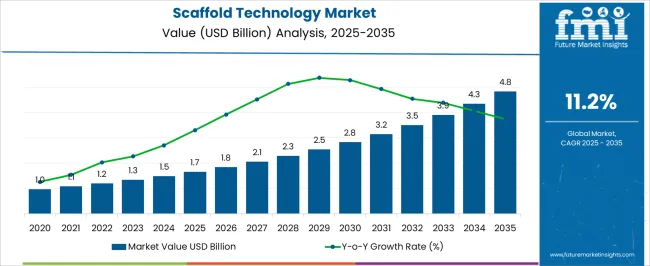
| Metric | Value |
|---|---|
| Scaffold Technology Market Estimated Value in (2025 E) | USD 1.7 billion |
| Scaffold Technology Market Forecast Value in (2035 F) | USD 4.8 billion |
| Forecast CAGR (2025 to 2035) | 11.2% |
The scaffold technology market is expanding at a strong pace, propelled by advancements in regenerative medicine, rising investment in tissue engineering research, and increasing clinical demand for personalized therapeutic solutions. Publications from biomedical journals and updates from biotech companies have emphasized the critical role of scaffolds in supporting cell growth, differentiation, and tissue regeneration.
Hydrogels and nanofiber-based scaffolds have gained prominence due to their biomimetic properties, while healthcare systems have accelerated adoption of scaffold-based therapies in orthopedics and wound care. Funding from government bodies and strategic collaborations between academic institutions and life sciences companies have reinforced innovation pipelines, enabling the development of biocompatible and functionalized scaffold products.
Furthermore, regulatory approvals of scaffold-based solutions for specific clinical applications have expanded commercialization potential. Future growth will be shaped by increasing adoption in stem cell therapy, expansion into musculoskeletal and spinal applications, and integration of 3D bioprinting technologies to design customized scaffold structures for patient-specific therapies.
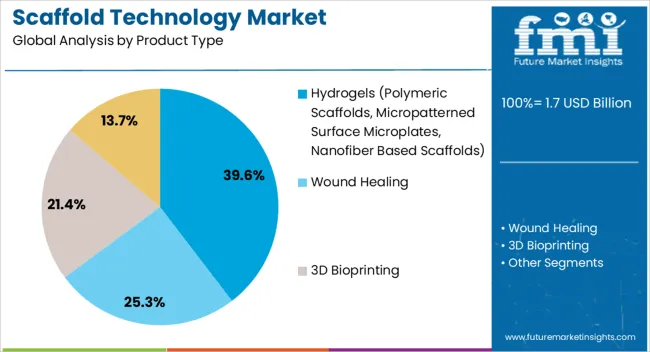
The Hydrogels segment is projected to account for 39.6% of the scaffold technology market revenue in 2025, reflecting its leading role among product types. Growth in this segment has been supported by the high biocompatibility, tunable mechanical properties, and ability of hydrogels to mimic the natural extracellular matrix.
Biomedical research has highlighted hydrogels as effective carriers for cells and bioactive molecules, making them ideal for regenerative medicine and drug delivery. The development of polymeric scaffolds, micropatterned surface microplates, and nanofiber-based hydrogel scaffolds has expanded their functional use in diverse applications.
Furthermore, hydrogels are adaptable for 3D bioprinting, which has accelerated their integration into tissue engineering solutions. Clinical studies have validated their performance in supporting tissue growth while reducing immune response, reinforcing their adoption in translational research. These advantages are expected to sustain hydrogels as the preferred scaffold type in both research and therapeutic settings.
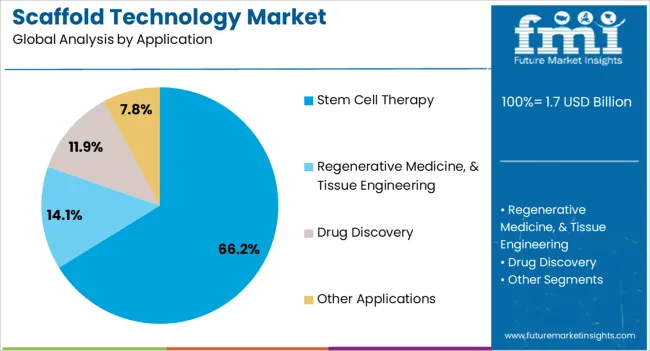
The Stem Cell Therapy segment is projected to hold 66.2% of the scaffold technology market revenue in 2025, making it the dominant application. This leadership has been driven by the increasing use of scaffolds as supportive matrices that enhance stem cell survival, proliferation, and differentiation.
Clinical research has demonstrated that scaffold-based delivery systems significantly improve the therapeutic efficacy of stem cell therapies by providing structural support and controlled microenvironments. Academic institutions and biotech companies have invested heavily in scaffold-integrated stem cell platforms for applications in regenerative medicine, cardiovascular repair, and neurodegenerative conditions.
Additionally, collaborations between stem cell banks, scaffold manufacturers, and healthcare providers have accelerated translational research and clinical trials. The strong synergy between scaffold innovation and stem cell therapy advancement is expected to keep this application at the forefront of market demand.
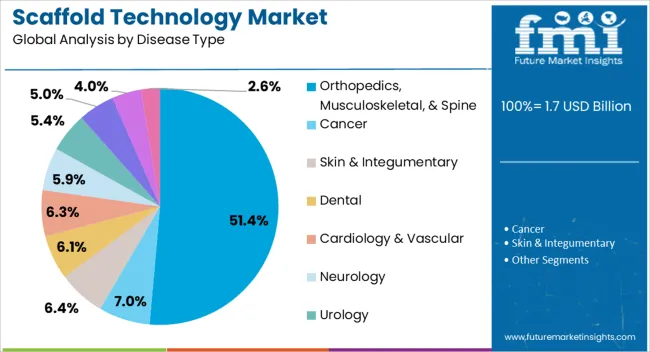
The Orthopedics, Musculoskeletal, & Spine segment is projected to contribute 51.4% of the scaffold technology market revenue in 2025, retaining its position as the largest disease type category. Growth in this segment has been supported by the increasing prevalence of bone and joint disorders, traumatic injuries, and degenerative spine conditions.
Scaffold-based solutions have gained acceptance in orthopedic surgery and rehabilitation due to their ability to promote bone regeneration and support musculoskeletal tissue repair. Clinical evidence has shown that scaffold integration with bioactive molecules and stem cells enhances healing outcomes and reduces recovery time.
Moreover, the aging global population has heightened the demand for advanced solutions for osteoporosis and arthritis-related complications. Healthcare investments in orthopedic regenerative therapies and the introduction of scaffold-based implants have further strengthened adoption in this area. With continued advancements in biomaterial engineering and 3D bioprinting for patient-specific implants, this segment is expected to maintain its dominant share of the market.
| Historical CAGR (2020 to 2025) | 12.7% |
|---|---|
| Forecast CAGR (2025 to 2035) | 11.3% |
The scaffold technology industrial historical performance reveals a remarkable tale of growth, characterized by a CAGR of 12.7% from 2020 to 2025. This impressive ascent underscores the resilience and adaptability of the ecosystem amidst evolving construction practices and technological advancements.
Throughout this period, scaffold technology has emerged as a cornerstone of modern construction, providing essential support structures for skyscrapers, bridges, and infrastructure projects worldwide.
Looking ahead, the forecasted CAGR of 11.3% from 2025 to 2035 heralds a promising future for the scaffold technology industry. As construction practices continue to evolve and demand for sustainable, efficient, and safe building solutions grows, scaffold technology is poised to play an important role in shaping the skyline of tomorrow.
The below section shows the leading segment. Based on the application, the stem cell treatment, regenerative medicine, and tissue engineering segment is accounted to hold a market share of 66.2% in 2025. Based on disease type, the orthopedics, musculoskeletal, & spine segment is accounted to hold a market share of 51.4% in 2025.
| Category | Market Share in 2025 |
|---|---|
| Stem Cell Treatment, Regenerative Medicine, and Tissue Engineering | 66.2% |
| Orthopedics, Musculoskeletal, & Spine | 51.4% |
Based on the application, the stem cell treatment, regenerative medicine, and tissue engineering segment is accounted to hold a market share of 66.2% in 2025.
The prominence of the segment stems from the growing adoption of stem cell therapies and regenerative medicine techniques for treating a wide range of diseases and injuries. Stem cell treatments offer promising avenues for regenerating damaged tissues, repairing injuries, and addressing degenerative conditions, attracting significant interest from patients, healthcare providers, and researchers alike.
The application of stem cells in tissue engineering holds immense potential for developing innovative solutions for organ transplantation and tissue repair, contributing to the commanding share of the segment.
Based on disease type, the orthopedics, musculoskeletal, and spine segment is accounted to hold a market share of 51.4% in 2025.
The prominence of the segment reflects the prevalence of orthopedic disorders, musculoskeletal injuries, and spine-related conditions, which represent significant healthcare burdens globally.
Stem cell therapies and regenerative medicine techniques offer promising alternatives to traditional treatments for orthopedic and spine-related ailments, including osteoarthritis, spinal cord injuries, and degenerative disc diseases.
As patients seek effective and minimally invasive treatment options to alleviate pain, restore function, and improve quality of life, the orthopedics, musculoskeletal, and spine segment continues to propel the demand for innovative regenerative therapies and stem cell treatments, thus reshaping the industry.
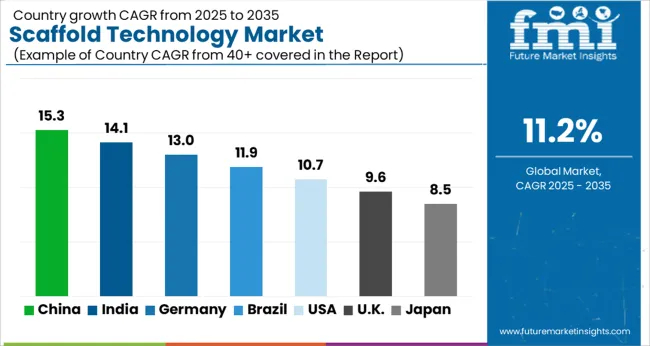
The table describes the top five countries ranked by revenue, with the United States holding the top position. The researchers and clinicians of the United States pioneer innovative treatments, utilizing scaffold scaffolds to engineer tissues and organs, thus advancing medical science and offering hope to patients in need of life-saving interventions.
The industry is led significantly by sales of scaffold technologies in the United States, Spain, and Italy. North America emerges as a key industry at a global level. Followed by Southern Europe sees demand rising at an impressive pace. However, the demand surges prominently due to the need for the integration of stem cell technologies with scaffolds to create functional tissues.
Forecast CAGRs from 2025 to 2035
| Countries | CAGR |
|---|---|
| The United States | 12.7% |
| The United Kingdom | 8.2% |
| France | 8.5% |
| Spain | 11.2% |
| Italy | 10% |
In the United States, with a notable CAGR of 12.7%, scaffold technology is predominantly used in tissue engineering and regenerative medicine applications.
Advanced scaffold materials and fabrication techniques are employed in research institutions and medical centers to develop innovative therapies for tissue repair, organ regeneration, and wound healing.
In the United Kingdom, where the market exhibits a CAGR of 8.2%, scaffold technology finds extensive utilization in orthopedic and musculoskeletal applications.
Scaffold scaffolds are used in orthopedic surgeries, such as bone grafting and joint replacements, to support tissue regeneration and facilitate bone healing, catering to the needs of patients with orthopedic injuries and conditions.
In France, with a CAGR of 8.5%, scaffold technology is primarily utilized in regenerative medicine and tissue engineering for addressing various medical conditions.
The government thus initiates necessary funding and asks its French researchers and healthcare providers to leverage scaffold scaffolds to develop novel treatments for cardiovascular diseases, neurological disorders, and skin injuries, showcasing the versatility and potential of scaffold technology in medical advancements.
In Spain, where the market boasts a robust CAGR of 11.2%, the industry is majorly employed in the field of regenerative medicine and organ transplantation.
Spanish scientists and clinicians utilize scaffold scaffolds to engineer tissues and organs for transplantation, offering hope to patients awaiting life-saving procedures and advancing the frontier of regenerative medicine.
In Italy, with a solid CAGR of 10%, scaffold technology is predominantly used in tissue engineering and wound healing applications.
The researchers and healthcare professionals od Italy harness scaffold scaffolds to develop advanced wound dressings, skin substitutes, and tissue-engineered constructs for treating chronic wounds, burns, and skin injuries, addressing significant healthcare challenges and improving patient outcomes.
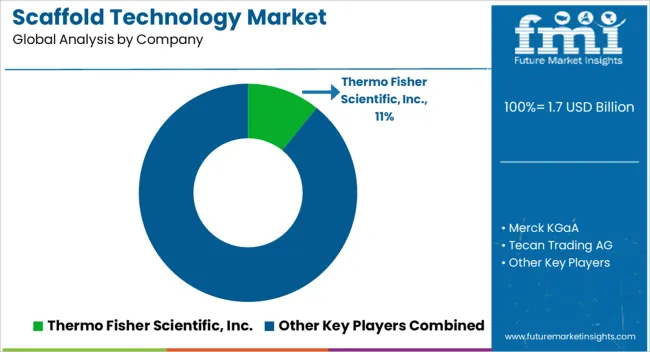
Intense competition fosters innovation, with companies focusing on advanced scaffold materials, customizable designs, and strategies for new entrants to target niche markets.
With a surge in demand for regenerative medicine and tissue engineering solutions, competition augments continuous advancements, propelling the scaffold technology industry toward new heights of growth and innovation.
Some of the key developments
| Attributes | Details |
|---|---|
| Estimated Market Size in 2025 | USD 1,490.7 million |
| Projected Market Valuation in 2035 | USD 4,348.6 million |
| Value-based CAGR 2025 to 2035 | 11.3% |
| Forecast Period | 2025 to 2035 |
| Historical Data Available for | 2020 to 2025 |
| Market Analysis | Value in USD million |
| Key Regions Covered |
North America; Latin America; Western Europe; Eastern Europe; South Asia and Pacific; East Asia; The Middle East and Africa |
| Key Market Segments Covered |
Product Type, Application, Disease, End-use, Region |
| Key Countries Profiled |
The United States, Canada, Brazil, Mexico, Germany, The United Kingdom, France, Spain, Italy, Russia, Poland, Czech Republic, Romania, India, Bangladesh, Australia, New Zealand, China, Japan, South Korea, GCC Countries, South Africa, Israel |
| Key Companies Profiled |
Thermo Fisher Scientific Inc.; Merck KGaA; Tecan Trading AG; REPROCELL Inc.; 3D Biotek LLC; Becton; Dickinson, and Company; Medtronic; Xanofi; Molecular Matrix Inc.; Matricel GmbH; Pelobiotech; 4titude; Corning Incorporated; Akron Biotech; Bioquote Ltd.; Avacta Life Sciences Limited; Nanofiber Solutions; Vericel Corporation; NuVasive Inc.; Allergan. |
The market is classified into Hydrogels (Polymeric Scaffolds, Micropatterned Surface Microplates, Nanofiber Based Scaffolds), Wound Healing, 3D Bioprinting, and Immunomodulation
The report consists of key sourcing, such as Stem Cell Therapy, Regenerative Medicine, & Tissue Engineering, Drug Discovery, and Other Applications
The industrial insights comprise Orthopedics, Musculoskeletal, & Spine, Cancer, Skin & Integumentary, Dental, Cardiology & Vascular, Neurology, Urology, GI, Gynecology, and Other Disease Types
Key end users present in the industry include Biotechnology and Pharmaceutical Industries, Research Laboratories and Institutes, Hospitals and Diagnostic Centers, and Other End-uses
Analysis of the market has been carried out in key countries of North America, Latin America, Western Europe, South Asia, East Asia, Eastern Europe, and the Middle East and Africa.
The global scaffold technology market is estimated to be valued at USD 1.7 billion in 2025.
The market size for the scaffold technology market is projected to reach USD 4.8 billion by 2035.
The scaffold technology market is expected to grow at a 11.2% CAGR between 2025 and 2035.
The key product types in scaffold technology market are hydrogels (polymeric scaffolds, micropatterned surface microplates, nanofiber based scaffolds), wound healing, 3D bioprinting and immunomodulation.
In terms of application, stem cell therapy segment to command 66.2% share in the scaffold technology market in 2025.






Full Research Suite comprises of:
Market outlook & trends analysis
Interviews & case studies
Strategic recommendations
Vendor profiles & capabilities analysis
5-year forecasts
8 regions and 60+ country-level data splits
Market segment data splits
12 months of continuous data updates
DELIVERED AS:
PDF EXCEL ONLINE
Bioresorbable Coronary Scaffolds Market
4K Technology Market Size and Share Forecast Outlook 2025 to 2035
5G technology market Analysis by Technology Type, Application, Vertical, and Region – Growth, trends and forecast from 2025 to 2035
8K Technology Market
Nanotechnology Photocatalysis Surface Coating Industry Analysis in AMEA Size and Share Forecast Outlook 2025 to 2035
Nanotechnology Packaging Market Size and Share Forecast Outlook 2025 to 2035
Key Players & Market Share in GDS Technology Market
GDS Technology Market Insights - Growth & Forecast 2025 to 2035
Nanotechnology for food packaging Market
Food Technology Market Size and Share Forecast Outlook 2025 to 2035
Smart-Technology Anti-Wrinkle Peptides Market Size and Share Forecast Outlook 2025 to 2035
Laser Technology Market Size and Share Forecast Outlook 2025 to 2035
Green Technology And Sustainability Market Size and Share Forecast Outlook 2025 to 2035
Camera Technology Market Analysis – Trends & Forecast 2025 to 2035
Battery Technology Market Size and Share Forecast Outlook 2025 to 2035
Airline Technology Integration Market Size and Share Forecast Outlook 2025 to 2035
Food Biotechnology Market Size and Share Forecast Outlook 2025 to 2035
IO-Link technology Market Size and Share Forecast Outlook 2025 to 2035
Ablation Technology Market Size, Share, and Forecast Outlook 2025 to 2035
Sapphire Technology Market Trends – Growth & Forecast 2025 to 2035

Thank you!
You will receive an email from our Business Development Manager. Please be sure to check your SPAM/JUNK folder too.
Chat With
MaRIA